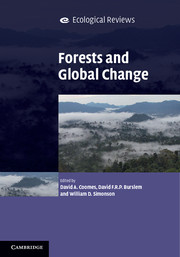Book contents
- Frontmatter
- Contents
- List of Contributors
- Preface
- Chapter One Forests and global change: an overview
- Part I Forest dynamics and global change
- Part II Species traits and responses to changing resource availability
- Part III Detecting and modelling global change
- Chapter Twelve A chemical-evolutionary basis for remote sensing of tropical forest diversity
- Chapter Thirteen Forests in a greenhouse atmosphere: predicting the unpredictable?
- Chapter Fourteen Detecting and projecting changes in forest biomass from plot data
- Chapter Fifteen Analysis of anthropogenic impacts on forest biodiversity as a contribution to empirical theory
- Index
- Plate Section
- References
Chapter Fifteen - Analysis of anthropogenic impacts on forest biodiversity as a contribution to empirical theory
Published online by Cambridge University Press: 05 June 2014
- Frontmatter
- Contents
- List of Contributors
- Preface
- Chapter One Forests and global change: an overview
- Part I Forest dynamics and global change
- Part II Species traits and responses to changing resource availability
- Part III Detecting and modelling global change
- Chapter Twelve A chemical-evolutionary basis for remote sensing of tropical forest diversity
- Chapter Thirteen Forests in a greenhouse atmosphere: predicting the unpredictable?
- Chapter Fourteen Detecting and projecting changes in forest biomass from plot data
- Chapter Fifteen Analysis of anthropogenic impacts on forest biodiversity as a contribution to empirical theory
- Index
- Plate Section
- References
Summary
Introduction
The widespread loss and degradation of native forests is now recognised as a major environmental issue, even a crisis (Spilsbury 2010). During the first decade of the twenty-first century, global forest area declined by around 13 million ha yr−1 (FAO 2010). However, such estimates based on national statistics are uncertain (Grainger 2008); Hansen et al. (2010) report a substantially higher annual forest loss of approximately 20 million ha yr−1 for 2000–2005, based on analysis of satellite imagery.
The Food and Agriculture Organization (FAO 2010) also report that during the decade 2000–2010, the area of undisturbed primary forest declined by an estimated 4.2 million ha yr−1 (or 0.4% annually), largely because of the introduction of selective logging and other forms of human disturbance. Accurate data on the extent of forest degradation at the global scale are difficult to obtain (Gibbs et al. 2007), but an indication of its impact is provided by a recent estimate of the amount of carbon stored in forest vegetation. Over the period 1990–2005, global forest carbon stocks declined, in percentage terms, by almost double the decline in forest area (UNEP 2007). Given the current emphasis of global forest policy initiatives on both deforestation and forest degradation, particularly in the context of the UN REDD+ programme, there is an urgent need not only for improved forest monitoring (Baker et al. 2010; Gibbs et al. 2007; Grainger 2008; Sasaki & Putz 2009), but for a deeper understanding of the processes responsible for forest degradation and their potential impacts on forest biodiversity.
- Type
- Chapter
- Information
- Forests and Global Change , pp. 417 - 446Publisher: Cambridge University PressPrint publication year: 2014
References
- 6
- Cited by

